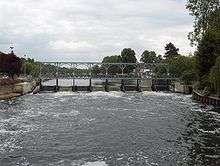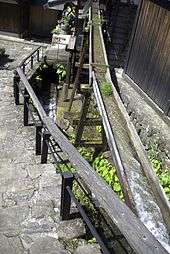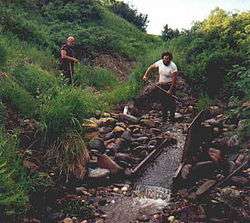Sluice




A sluice (from the Dutch "sluis") is a water channel controlled at its head by a gate. A mill race, leet, flume, penstock or lade is a sluice channelling water toward a water mill. The terms sluice, sluice gate, knife gate, and slide gate are used interchangeably in the water and wastewater control industry.
A sluice gate is traditionally a wood or metal barrier sliding in grooves that are set in the sides of the waterway. Sluice gates commonly control water levels and flow rates in rivers and canals. They are also used in wastewater treatment plants and to recover minerals in mining operations, and in watermills.
Operation
"Sluice gate" refers to a movable gate allowing water to flow under it. When a sluice is lowered, water may spill over the top, in which case the gate operates as a weir. Usually, a mechanism drives the sluice up or down. This may be a simple, hand-operated, chain pulled/lowered, worm drive or rack-and-pinion drive, or it may be electrically or hydraulically powered.
Types of sluice gates
- Flap sluice gate
- A fully automatic type, controlled by the pressure head across it; operation is similar to that of a check valve. It is a gate hinged at the top. When pressure is from one side, the gate is kept closed; a pressure from the other side opens the sluice when a threshold pressure is surpassed.
- Vertical rising sluice gate
- A plate sliding in the vertical direction, which may be controlled by machinery.
- Radial sluice gate
- A structure, where a small part of a cylindrical surface serves as the gate, supported by radial constructions going through the cylinder's radius. On occasion, a counterweight is provided.
- Rising sector sluice gate
- Also a part of a cylindrical surface, which rests at the bottom of the channel and rises by rotating around its centre.
- Needle sluice
- A sluice formed by a number of thin needles held against a solid frame through water pressure as in a needle dam.
The gates of a Guillotine lock work in a way similar to a sluice gate, but most canal lock gates are hinged to swing like doors.
Logging sluices
In the mountains of the United States, sluices transported logs from steep hillsides to downslope sawmill ponds or yarding areas. Nineteenth-century logging was traditionally a winter activity for men who spent summers working on farms. Where there were freezing nights, water might be applied to logging sluices every night so a fresh coating of slippery ice would reduce friction of logs placed in the sluice the following morning.[1]
Placer mining applications
Sluice boxes are often used in the recovery of black sands, gold, and other minerals from placer deposits during placer mining operations. They may be small-scale, as used in prospecting, or much larger, as in commercial operations, where the material is first screened using a trommel or screening plant. Typical sluices have transverse riffles over a carpet, which trap the heavy minerals, gemstones, and other valuable minerals. The result is a concentrate.
Types of material used for sluice gates
- Cast Iron
- Cast iron has been popular when constructing sluice gates for years. This material is great at keeping the strength needed when dealing with powerful water levels.
- Stainless Steel
- Stainless steel in most cases is lighter than the older cast iron material.
- Fibre-reinforced plastic (FRP)
- Rather recently a new technologies such as fibre-reinforced plastic are being used to build sluices. This modern technology has many of the attributes as the older ways while bringing in new attributes such as corrosion resistance and much lighter weights.
Regional names for sluice gates
In the Somerset Levels, sluice gates are known as clyse[2] or clyce.[3][4]
Most of the inhabitants of Guyana refer to sluices as kokers.
Sinhala people in Sri Lanka who had a harvested rain water based ancient civilization refer to sluices as Horovuwa.[5]
See also
- Floodgate
- Gatehouse (waterworks) – An (elaborate) structure to house a sluice gate
- Lock
- Zijlstra – A Dutch name referring to one who lives near a sluice
References
- ↑ Jones, Robert C. (1979). Two Feet Between the Rails (Volume 1 - The Early Years). Sundance Books. ISBN 0-913582-17-4.
- ↑ "FOCUS on Industrial Archaeology No. 68, June 2007". Hampshire Industrial Archaeology Society website. Archived from the original on 2007-11-10. Retrieved 2007-10-30.
- ↑ Dunning R. W. (2004). History of the County of Somerset: Volume 8: The Poldens and the Levels (Victoria County History). Oxford: Oxford University Press. ISBN 1-904356-33-8.
- ↑ "'Huntspill', A History of the County of Somerset: Volume 8: The Poldens and the Levels". British History Online. Retrieved 2007-10-30.
- ↑ "The water regulation technology of ancient Sri Lankan reservoirs: The Bisokotuwa sluice" (PDF). slageconr.net. p. 1. Retrieved 14 August 2012.
Further reading
- Crittenden, H. Temple (1976). The Maine Scenic Route. McClain Printing.
- Moody, Linwood W. (1959). The Maine Two-Footers. Howell-North.
- Cornwall, L. Peter & Farrell, Jack W. (1973). Ride the Sandy River. Pacific Fast Mail.
External links
| Wikimedia Commons has media related to Sluices. |
| Look up sluice in Wiktionary, the free dictionary. |